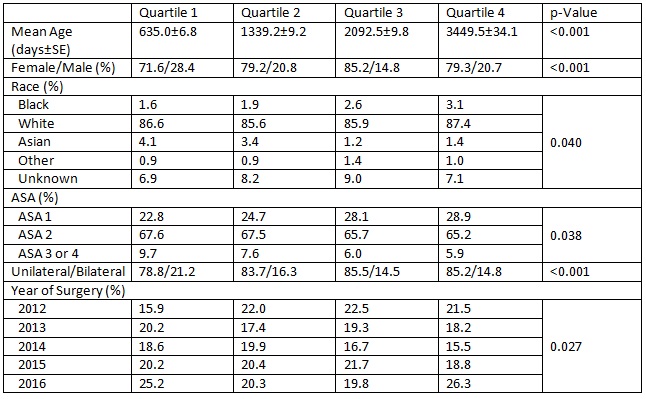Does Age Matter? An Analysis of 30-Day Open Ureteroneocystomy Outcomes
Kristina D. Suson, MD, Janae Preece, MD, Yegappan Lakshmanan, MD.
Children's Hospital of Michigan, Detroit, MI, USA.
BACKGROUND: Since the release of the American Academy of Pediatrics 2011 febrile urinary tract infection guidelines, fewer voiding cystourethrograms have been ordered, and subsequently, fewer children have been diagnosed with vesicoureteral reflux. Theoretically, children with clinically significant reflux may then be diagnosed at a later age. We hypothesize that older patients will have a more complicated peri-operative course.
METHODS: The American College of Surgeons National Surgical Quality Improvement Program Pediatric data file was queried for all children over one year of age undergoing ureteral reimplantation of a single system ureter for vesicoureteral reflux by pediatric urology between 2012 and 2016. Children undergoing surgery for other indications or who underwent concomitant procedures were excluded. Data points included: demographic information, procedures, diagnoses, operative time, lengths of stay, complications, readmission, and reoperation. The children were divided into quartiles by age (Quartile 1 = Q1, Quartile 2 = Q2, Quartile 3 = Q3, Quartile 4 = Q4), then compared with Chi-squared and ANOVA analyses.
RESULTS: Pre-operative data for the 2,324 patients included in the study are presented in the table. There was no difference in whether the surgery was inpatient: Q1 84.3%, Q2 82.3%, Q3 79.9%, Q4 83.3% (p=0.224). The mean operating time in minutes was longer for the oldest quartile: Q1 130.2±2.0, Q2 129.1±2.0, 134.7±2.3, Q4 142.4±2.5 (p<0.001). There was no difference identified in length of stay: Q1 1.6±0.2, Q2 1.9±0.1, Q3 1.9±0.2, Q4 1.8±0.1 (p=0.331). There was no difference in the overall complication rate (Q1 4.3%, Q2 4.3%, Q3 3.1%, Q4 3.4%, p=0.616). There was also no difference in specifically rate of the most common complication, urinary tract infection (Q1 2.1%, Q2 2.7%, Q3 2.4%, Q4 2.1%, p=0.845). The youngest quartile was more likely to require reoperation: Q1 2.2%, Q2 0.5%, Q3 0.3%, Q4 0.5% (p=0.001). The youngest two quartiles were more likely to be readmitted: Q1 6.2%, Q2 4.1%, Q3 2.2%, Q4 2.9% (p=0.003).
CONCLUSIONS: Pre-operative characteristics, including gender, race, and ASA classification, differ between age groups. While the operative times are longer for the oldest quartile, the other immediate post-operative outcomes are similar or improved when compared to younger children. 
Back to 2019 Abstracts




